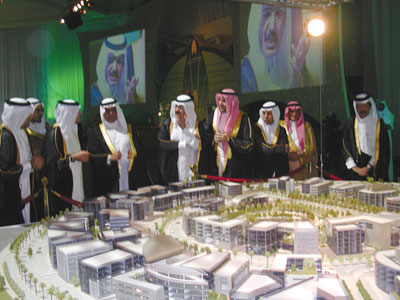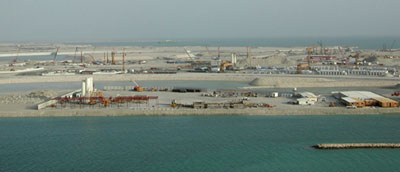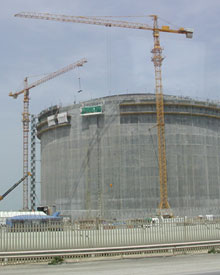
|
|
|
From Site Selection magazine, May 2006
WORLD REPORTS
|
|
|
Energy City is Qatar’s
Latest Leap Forward
evelopers of the planned US$2.6-billion Energy City Qatar (ECQ) business hub in Doha want you to “Feel the Energy.” That’s not hard to do in this small peninsular country on Saudi Arabia’s east coast. Qatar is teeming with energy initiatives with more than $80 billion in current and planned projects. The country is set to be the world’s largest LNG exporter by 2012 as it continues to develop the vast natural gas reserves of the North Field, a region in the Arabian Gulf north of the country with proven reserves of more than 900 trillion cubic feet, the world’s third largest. While the one-of-a-kind ECQ complex is years away from housing the anticipated collection of regional headquarters for energy conglomerates and associated industries and suppliers, this small country is already on its way to being the region’s nexus of energy-related activity. Global energy investment and consulting group Gulf Energy, with the full backing of the Qatar government, is spearheading ECQ development. “There’s a lot of work to be done,” admits ECQ CEO Bob Moore, on the job since early March. The ECQ site is currently an empty piece of desert land, but Moore says he expects the first buildings to be built within the next two to three years. “It will be a home for the energy industry to interact or compete,” says Yvonne Sisler, manager, global gas, for PFC Energy, a consulting firm working with Gulf Energy. ECQ will become a regional nerve center of the energy sector as Qatar ramps up its exploitation of its vast gas and oil reserves. Energy minister Abdullah Bin Hamad Al Attiya said that Qatar
expects to export 77 million tons of LNG annually by 2012, compared to the current 25 million tons. Qatar also plans a fleet of 65 LNG tankers to handle the increased exports. The country will also increase its oil production from the current 800,000 barrels per day to 1.1 million by 2010. While no firms have signed on as initial occupants, Moore says the fact that the project has been endorsed by the top management of Chevron Corp., oil field services provider Schlumberger and Norwegian oil giant Statoil indicates the level of companies interested in the project. The effort received some early momentum on March 20 when Gulf Energy, ECQ’s developer, signed an agreement with the Qatar government to establish International Mercantile Exchange (IMEX), the Middle East’s first dedicated energy trading platform. Vahan Zanoyan, president and CEO of PFC Energy, an energy consultancy working with ECQ developers, says the concept of an “energy city” has been talked about around the Gulf for several years. He says Qatar is the ideal site for it. “Participants will be able to gain significant efficiencies due to the benefits of clustering, ease of interaction and communication, economies of scale and easier access to opportunities and decision makers,” Zanoyan says. ECQ, the Middle East’s first energy business center, will be part of the much larger Lusail Development, a sprawling project just north of Doha that will include business, residential and entertainment districts over 7.7 sq. miles (20 sq. km.). The project, costing tens of billions of dollars, will unfold over the next 20 years. Officials with Qatari Diar Real Estate Investment Co., the state-owned developer, say Lusail is a
natural northward extension of Doha. They envision 150,000 to 200,000 people, mostly expatriates working in the oil and gas industries, populating Lusail. Infrastructure Projects Punctuate Qatar’s Growth
While spectacular in their own right, ECQ and Lusail are just part of the Qatar chronicle of rapid growth. Construction cranes are seemingly as plentiful as palm trees in the country as Doha is awash with high-rises in various stages. Construction is rapidly moving along on major infrastructure projects aimed at serving Qatar’s rapid growth in the energy sector. The center of much of that growth is Ras Laffan Industrial City, along Qatar’s northwest coast. The city sprawls across 41 sq. miles (106 sq. km.) and is projected to expand to nearly 154 sq. miles (400 sq. km.) by 2010. The city is home to the country’s two major LNG projects, Qatargas and RasGas. RasGas is currently developing its fourth LNG train, one of the largest manufacturing facilities in the world, which will supply the European market. Construction began in September 2005 on the train,
set to be the world’s largest with an annual capacity of 7.8 million metric tons. The North Field’s immense natural gas reserve makes it economically feasible to produce helium. Qatargas and RasGas, along with French firm Air Liquide, developed a $115-million helium plant which began shipping helium in September 2005. The plant has an annual capacity of 650 million standard cubic feet of helium. Ras Laffan port is tripling in size over the next several years in anticipation of the predicted dramatic increases in hydrocarbon cargo. “Ras Laffan port will eventually be the largest hydrocarbon port on the globe,” says Joseph Angelil, commercial and information officer for Ras Laffan Industrial City. Qatar will have a modern airport to match its rising economic status by 2009. The new $5.5-billion Doha International Airport is being built on a 4,200-acre (1,700-hectare) site about 2.5 miles (four km.) east of the city’s existing antiquated airport. The first phase will be capable of handling 12 million passengers per year. When complete in 2015, the airport is expected to handle up to 50 million passengers and 2 million tons of cargo annually. The current airport handles 4.2 million passengers per year and is undergoing a $140-million interim expansion to boost capacity to 7.2 million. The new airport will be the world’s first to be designed and built specifically for Airbus’s new A380-800 double-decker “super jumbo” planes, the largest passenger aircraft ever, with a capacity of more than 550 passengers.
|

©2006 Conway
|



